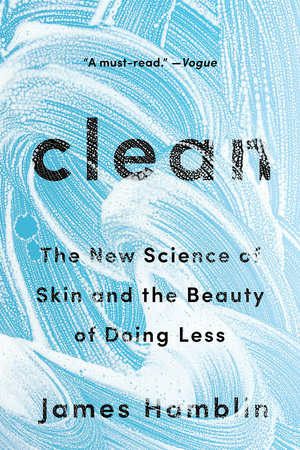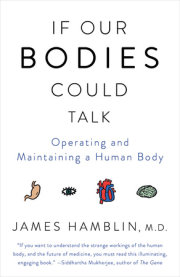I
Awaken
I walk off the elevator into a palatial, sun-soaked office looming seven stories over Bryant Park in Manhattan. It's the fall of 2018, some three years since I last washed my face. I'm here to see what the effects have been.
The herringbone wood floors are decorated with floral bouquets as tall as any human. The fireplace has a white mantel, and ethereal flute-based music wafts over me from somewhere. A bed draped in white linens awaits under a chandelier. This is the headquarters of an up-and-blazingly-coming skin care company called Peach and Lily. It's based in the Korean tradition and part of a Westernized movement commonly known as "K-beauty" that centers on maintenance of one's skin, often through a ritual of cleansing, toning, moisturizing, and sheet masking that can include ten or more steps.
The company's founder, Alicia Yoon, holds an MBA at Harvard Business School. She is also an esthetician, perhaps best known for her work in popularizing the application of snail secretions to the skin. In just two years, Yoon took Peach and Lily from a small internet boutique to a full line of original products distributed at retailers like Urban Outfitters and CVS. The company arrived on the crest of an enormous wave. In South Korea, where K-beauty is based on long-standing tradition, the industry has exploded to more than $13 billion per year. Its newfound popularity in the U.S. has helped make skin care a faster-growing segment of the beauty industry than makeup. Sales of high-end skin care grew 13 percent in 2018 alone, significantly faster than GDP.
I'm greeted at the elevator by a cheery assistant who asks me to disrobe. I explain that I've come to have a facial. She laughs and says she knows that, then hands me a robe and a questionnaire about my skin care routine and leaves me to change.
Alone in the space, I turn to the questionnaire, which looks like a form you might fill out in the waiting room of a doctor's office. There is a question about allergies and diet, along with a battery of questions about my skin: What exfoliants do I use? What moisturizers? What serums? What cleansers? How often have I been using each and in what order and combination?
This is a brief exercise for me, since I've been doing nothing. Yoon enters and welcomes me graciously, but the tone shifts when she sees the mostly blank form and learns that I have not simply forgotten to fill it out. "Oh my god," she says. "Are you safe to have a facial?"
"Yes! Of course-wait, why would I not be?" I hadn't really considered I was at risk before. Suddenly I'm worried. "I don't know-I mean, you tell me."
"It should probably be fine, I've just never done this on anyone . . . like this before," she trails off, either sad or disappointed or maybe both.
I lie down and she puts a bright light over my face. She touches my cheek lightly with her fingertip, then a little more firmly. Hesitantly, she says, "Have you ever felt your face?"
Funny she should ask.
I have made a point of almost never touching my face, ever since I was a teenager with "bad skin" who was under the now-obsolete impression that acne is caused by not cleaning well or aggressively enough. There were times the acne would extend to my eyelid as a stye that would nearly swell my eye shut. Social interaction became impossible because the appearance of my eye sucked all the attention out of any conversation. Even after my skin cleared up in college, I held on to the habit of keeping my hands-and the bacteria and viruses they carried-away from my face.
Not wanting to get into this long backstory, I tell Yoon that I touch my face "the normal amount," and she gets to work.
Yoon is no stranger to "problem" skin. She spent much of her life battling severe eczema, at times scratching her inflamed skin until there was no skin left to scratch. "I grew up trying everything under the sun, even bleach baths," she tells me, referring to the dubious practice intended to kill any and all microbes on one's skin.
But when she attended esthetician school in Korea, she began to experiment with new skin care rituals to calm the inflammation. Finding a routine of gentle, moisturizing products was part of what she has called her "skin-care breakthrough moment," and the approach she now shares with her clients.
Yoon applies Peach and Lily's Glass Skin Refining Serum (the bottle promises "translucent + luminous" skin as well as "peptides") and Pure Beam Luxe Oil ("replenish + rebalance" with jojoba oil) to my face, as well as a Super Reboot Resurfacing Mask containing blue agave, and a Matcha Pudding Antioxidant Cream. She recommends to me the Original Glow Sheet Mask for home use, as it contains hyaluronic acid.
Hyaluronic acid binds water, so it adds volume in the epidermis. Babies have a lot of hyaluronic acid, which is why their skin is smooth and firm and plump. Whether putting it on your skin is the same as having it in your skin is an open question. It does no good to cover your car in gasoline, or to fill your house with roofing shingles. According to dermatologists I've spoken with, some forms of the acid can sometimes penetrate into the skin, but only the ones that have smaller molecular weights. The Peach and Lily mask doesn't specify whether it's the type that penetrates the skin, but it does purport an "anti-aging" effect.
It is unlikely a coincidence that the skin care boom is happening at a time when people are losing trust in science and medicine, often for good reason. Dermatologists, like many other doctors, are typically scarce and expensive. And many people feel the profession has failed them. If it can ever be said that skin is "good" or "bad"-meaning uncomfortable, dry, irritated, itchy, painful, or otherwise causing us distress-then our collective skin is getting worse. Rates of the inflammatory skin condition known as atopic dermatitis, or eczema, are increasing rapidly. According to the World Health Organization, the prevalence of psoriasis more than doubled between 1979 and 2008. Acne continues to afflict people during prime years of social development, and research suggests it is also increasing in adults, especially among women.
The causes of these trends are complex, going far beyond the skin itself. For example, a 2018 review of studies in Clinical, Cosmetic and Investigational Dermatology suggested that one reason for the increase in acne in women is the hormonal imbalances associated with "metabolic syndrome"-the term for the constellation of diabetes, cardiovascular disease, and obesity. High insulin levels can cause the body to convert estrogen to testosterone, which signals growth factors in the skin that lead to more oil being secreted, changing bacterial populations and fueling a cycle of inflammation whose culmination is a pimple.
With elaborate processes like these underlying the appearance of skin, it's no wonder that topical treatments alone, for acne other common skin conditions, often work incomplete or unreliably. Systemic treatments are rarely less fickle. Oral contraceptives are sometimes prescribed in an attempt to even out an alleged hormonal imbalance. People tolerate these recalibrations very differently, and results vary from life-changing to useless-while coming with the side effects of changing one's entire body chemistry solely to address the skin. Antibiotics don't reliably help either, and powerful drugs like Accutane carry the potential to cause birth defects and, many users report, intense depression. In psoriasis and eczema, a person may cycle on and off steroid treatments for much of a life time, never finding a definitive cure or even knowing when or why a flare will occur. The overall effect of such trial and error can leave patients believing they might as well take matters into their own hands.
Desire for control and certainty also leaves people wanting preventive approaches, of the sort that the medical system has not traditionally taken seriously. Yoon is seeing growing demand for products that promise to "nourish" or "protect" the skin. This is also partly due to growing concerns about air pollution, she hears from consumers, and about increasingly intense ultraviolet radiation from the sun as greenhouse gases dissolve the ozone layer. As the Earth loses this protective shell, people are compelled to apply their own.
Each of the products Yoon applies to my face promises some amalgamation of attractiveness, protection, and maintenance-blurring the line between cosmetic enhancement and essential defense against toxins and other ambient dangers. She likens some of the rituals to providing nutrition for my face, saying they will help "make sure your skin has the vitamins and minerals and fatty acids to thrive." I begin to feel negligent.
Cosmetics are not food, legally. They are also distinct, in a regulatory sense, from drugs in that they can't claim to treat or prevent specific diseases. But sellers can market these products with claims about improving and maintaining health-without all the bureaucratic burden of getting a drug approved to be sold on the market. Yoon is part of a new generation of entrepreneurs who exist in a place that is not quite health or beauty but a mix of both. New skin care products promise to obviate the need for makeup and medicines by making the skin look "naturally" good. These products are not simply offering a recreational way of temporarily altering our appearance but are getting much closer to what would usually be considered drugs-implying that they are preventing or fixing a problem in the functioning of the skin.
The new industry bypasses traditional gatekeepers, as products can be aggressively marketed right in our Instagram feeds. YouTube influencers build personal brands based on anti-establishment solutions to skin "problems," speaking with the kind of persuasive personalities that medical school seems designed to kill off. Here, everyone is an expert. No mountain of studies is likely to override what worked or didn't work for you.
If you've ever been unhappy with your skin, the appeal of these sorts of promises is probably clear. When the antibiotics recommended by my dermatologist didn't help with my teenage acne, my innovative dentist father even suggested that since trying yet more oral antibiotics could have undesirable side effects, I might apply them topically. So I took tetracycline capsules and broke them open, mixed them in water, and rubbed that all over my face. Then, instead of simply redness and lumpiness, I had a yellowish hue. People asked if I had been using some kind of tanning spray, as some midwestern teenagers did at the time to simulate the appearance of having gone outside. I laughed and told them that was ridiculous. In fact I had tried that, along with most anything else, to attempt to even out the very weird palette of my face. But you know what happens when you add orange to red and yellow? You get a weirder orange. Even less natural-looking, even more disconcerting.
Lying on the crisp linens at Peach and Lily, above the noise and impersonality of the city streets below, I'm not thinking about marketing or my teenage angst-or much at all. If you have never had your face massaged, let me assure you it is wonderful. More than just the physical sensation of the massage and the application of products, it's an act that takes you instantly out of whatever stressful things are happening in your life, into a feeling of being temporary royalty. Another human is taking the time and effort to rub your face, simply to make you feel and look good.
When the renovation is complete, Yoon loads up a bag full of samples for me to experiment with at home. She can't give me any of the Glass Skin Refining Serum because it's out of stock everywhere and even she doesn't have enough. It sold out instantly upon being announced.
"You need to take care of your face," she tells me, urging me to at least use a cleanser. I laugh; she doesn't. I flush. As I get into the elevator, she says again, firmly: "More needs to be done."
When I emerge onto the street post-facial, from what was apparently a cocoon of dead skin and oil on my face (who knew?), I experience the world differently. I step out into the sunlight and-this might be hard to believe if you've never gone years without cleaning your face and then had a wildly fancy facial-I can feel the world with my face in a way I didn't know was possible. My skin-I touched it-is definitely softer. And though it may only be in my head, I instantly feel like I am being seen differently. Maybe because of some kind of newly confident spring in my step, or because I actually look more attractive. Maybe I simply look like a person with the means to put matcha on my face.
In any case, I feel changed. Sometimes that's a perfectly sufficient thing to want. Not necessarily to be better, just different. I'm reminded of how easy it can be to get used to the way the world treats us, and come to conceive of our place in it accordingly. Once we do, it's easy to take notice of only the outlier experiences-when people are nicer or meaner to us than we've come to think we deserve. This effect is also drawn out in other moments of dramatic physical change like getting really dressed up or getting a wildly different haircut. The very real ways that appearances inform the way people treat other people are uncomfortably palpable in those moments.
The other change I feel will be more lasting. Up until this moment, I had been fine without facials for my entire life. If they had ever even crossed my mind, I probably would have dismissed them as self-indulgent vanity and, if I'm honest, as a child of Indiana, not something men do. At the very least, facials weren't something I was interested in spending my time and money on. But seeing how something as simple as someone rubbing things into my face could change the way I move through the entire day, the sense of frivolity vanishes. I see how, like so many things that feel extravagant the first time, these serums and oils and masks could lose their initial feeling of luxury and start to feel routine, even necessary.
Many of the cleaning habits we now take for granted started relatively recently. Over the course of just a few centuries, social and personal standards for hygiene and cleanliness in much of the world have expanded from an occasional jump in the river to an essential daily shower or bath. Now to even speak of not showering is, as it's been put to me, "not really dinner conversation."
Copyright © 2020 by James Hamblin. All rights reserved. No part of this excerpt may be reproduced or reprinted without permission in writing from the publisher.








